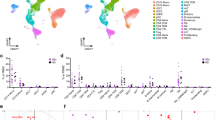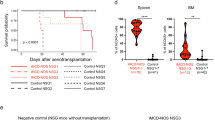Abstract
The etiology of idiopathic multicentric Castleman disease (iMCD) is poorly understood, and the identification of targetable disease mediators remains an unmet clinical need. Thus, we firstly employed single-cell RNA sequencing (scRNA-seq) to elucidate the landscape of the immune repertoire of peripheral blood mononuclear cells (PBMNCs) in iMCD and to identify additional driver cytokines/cells/pathways to address IL-6 blockade-refractory cases. We revealed that the inflammatory cytokine storm observed in iMCD was a significant phenomenon pervasive across all immune cells. B-plasma cell subsets was the main source of IL-6. The IL-6 signaling pathway was significantly activated across a spectrum of immune cells. Systemic upregulation of CXCL13 is mainly driven by peripheral helper T (Tph) and regulatory T (Treg) cells. Notably, a significant positive interaction was observed between CXCL13-expressing T cells and IL‐6 signaling-activated B cells. This study provides an immune perspective on PBMNCs in iMCD at the single-cell level, unveiling pathways or targets characterized by atypical inflammatory expression that could potentially serve as promising candidates for therapeutic intervention in iMCD.

This is a preview of subscription content, access via your institution
Access options
Subscribe to this journal
Receive 50 print issues and online access
269,00 € per year
only 5,38 € per issue
Buy this article
- Purchase on SpringerLink
- Instant access to full article PDF
Prices may be subject to local taxes which are calculated during checkout






Similar content being viewed by others
Data availability
The raw data supporting the conclusions of this article will be made available by the authors without undue reservation to any qualified researcher.
References
Fajgenbaum DC, Uldrick TS, Bagg A, Frank D, Wu D, Srkalovic G, et al. International, evidence-based consensus diagnostic criteria for HHV-8-negative/idiopathic multicentric Castleman disease. Blood. 2017;129:1646–57.
Yoshizaki K, Murayama S, Ito H, Koga T. The role of interleukin-6 in Castleman disease. Hematol Oncol Clin North Am. 2018;32:23–36.
Lang E, van Rhee F. Idiopathic multicentric Castleman disease: an update in diagnosis and treatment advances. Blood Rev. 2023;64:101161.
van Rhee F, Wong RS, Munshi N, Rossi JF, Ke XY, Fosså A, et al. Siltuximab for multicentric Castleman’s disease: a randomised, double-blind, placebo-controlled trial. Lancet Oncol. 2014;15:966–74.
Fraticelli S, Lucioni M, Neri G, Marchiori D, Cristinelli C, Merli M, et al. T-cells subsets in Castleman disease: analysis of 28 Cases including unicentric, multicentric and HHV8-related clinical forms. Int J Mol Sci. 2023;24:7813.
Horna P, King RL, Jevremovic D, Fajgenbaum DC, Dispenzieri A. The lymph node transcriptome of unicentric and idiopathic multicentric Castleman disease. Haematologica. 2023;108:207–18.
Pierson SK, Stonestrom AJ, Shilling D, Ruth J, Nabel CS, Singh A, et al. Plasma proteomics identifies a ‘chemokine storm’ in idiopathic multicentric Castleman disease. Am J Hematol. 2018;93:902–12.
Pierson SK, Katz L, Williams R, Mumau M, Gonzalez M, Guzman S, et al. CXCL13 is a predictive biomarker in idiopathic multicentric Castleman disease. Nat Commun. 2022;13:7236.
Harada T, Kikushige Y, Miyamoto T, Uno K, Niiro H, Kawakami A, et al. Peripheral helper-T-cell-derived CXCL13 is a crucial pathogenic factor in idiopathic multicentric Castleman disease. Nat Commun. 2023;14:6959.
Nagy A, Bhaduri A, Shahmarvand N, Shahryari J, Zehnder JL, Warnke RA, et al. Next-generation sequencing of idiopathic multicentric and unicentric Castleman disease and follicular dendritic cell sarcomas. Blood Adv. 2018;2:481–91.
Wing A, Xu J, Meng W, Rosenfeld AM, Li EY, Wertheim G, et al. Transcriptome and unique cytokine microenvironment of Castleman disease. Mod Pathol. 2022;35:451–61.
Liberzon A, Birger C, Thorvaldsdóttir H, Ghandi M, Mesirov JP, Tamayo P. The Molecular Signatures Database (MSigDB) hallmark gene set collection. Cell Syst. 2015;1:417–25.
Paldor M, Levkovitch-Siany O, Eidelshtein D, Adar R, Enk CD, Marmary Y, et al. Single-cell transcriptomics reveals a senescence-associated IL-6/CCR6 axis driving radiodermatitis. EMBO Mol Med. 2022;14:e15653.
Nishimura MF, Igawa T, Gion Y, Tomita S, Inoue D, Izumozaki A, et al. Pulmonary manifestations of plasma cell type idiopathic multicentric Castleman disease: a clinicopathological study in comparison with IgG4-related disease. J Pers Med. 2020;10:269.
Yoshizaki K, Matsuda T, Nishimoto N, Kuritani T, Taeho L, Aozasa K, et al. Pathogenic significance of interleukin-6 (IL-6/BSF-2) in Castleman’s disease. Blood. 1989;74:1360–7.
Otani K, Inoue D, Fujikura K, Komori T, Abe-Suzuki S, Tajiri T, et al. Idiopathic multicentric Castleman’s disease: a clinicopathologic study in comparison with IgG4-related disease. Oncotarget. 2018;9:6691–706.
Iwaki N, Gion Y, Kondo E, Kawano M, Masunari T, Moro H, et al. Elevated serum interferon γ-induced protein 10 kDa is associated with TAFRO syndrome. Sci Rep. 2017;7:42316.
Liu AY, Nabel CS, Finkelman BS, Ruth JR, Kurzrock R, van Rhee F, et al. Idiopathic multicentric Castleman’s disease: a systematic literature review. Lancet Haematol. 2016;3:e163–175.
Tisoncik JR, Korth MJ, Simmons CP, Farrar J, Martin TR, Katze MG. Into the eye of the cytokine storm. Microbiol Mol Biol Rev. 2012;76:16–32.
Beck JT, Hsu SM, Wijdenes J, Bataille R, Klein B, Vesole D, et al. Brief report: alleviation of systemic manifestations of Castleman’s disease by monoclonal anti-interleukin-6 antibody. N Engl J Med. 1994;330:602–5.
Nishimoto N, Kanakura Y, Aozasa K, Johkoh T, Nakamura M, Nakano S, et al. Humanized anti-interleukin-6 receptor antibody treatment of multicentric Castleman disease. Blood. 2005;106:2627–32.
Hao, Han D, Sinjab G, Gomez-Bolanos LI A, Lazcano R, Serrano A, et al. The single-cell immunogenomic landscape of B and plasma cells in early-stage lung adenocarcinoma. Cancer Discov. 2022;12:2626–45.
Yu H, Shahsafaei A, Dorfman DM. Germinal-center T-helper-cell markers PD-1 and CXCL13 are both expressed by neoplastic cells in angioimmunoblastic T-cell lymphoma. Am J Clin Pathol. 2009;131:33–41.
Colgan JD. mTOR signaling as a driver of Castleman disease. Blood. 2020;135:1614–5.
Sumaiya K, Langford D, Natarajaseenivasan K, Shanmughapriya S. Macrophage migration inhibitory factor (MIF): a multifaceted cytokine regulated by genetic and physiological strategies. Pharmacol Ther. 2022;233:108024.
McGinnis CS, Murrow LM, Gartner ZJ. DoubletFinder: doublet detection in single-cell RNA sequencing data using artificial nearest neighbors. Cell Syst. 2019;8:329–37.e324.
Haghverdi L, Lun ATL, Morgan MD, Marioni JC. Batch effects in single-cell RNA-sequencing data are corrected by matching mutual nearest neighbors. Nat Biotechnol. 2018;36:421–7.
Jin S, Guerrero-Juarez CF, Zhang L, Chang I, Ramos R, Kuan CH, et al. Inference and analysis of cell-cell communication using CellChat. Nat Commun. 2021;12:1088.
Acknowledgements
We thank the patients newly diagnosed with iMCD volunteers for their peripheral blood samples and the medical staff of the Department of Hematology, First Affiliated Hospital, College of Medicine, Zhejiang University. We thank OE Biotech Co., Ltd (Shanghai, China) for providing single-cell RNA-seq. We thank Zhenbo Wang of the Cosmos Wisdom Biotech Co., Ltd. (Hangzhou, China) for analyzing the data. We thank Cosmos Wisdom Biotech Co., Ltd. (Hangzhou, China) for providing single-cell related services.
Funding
This research was supported by Zhejiang Provincial Natural Science Foundation of China (Grant No. LZ23H080002 and LQ24H080005) and the National Natural Science Foundation of China (Grant No.82100241).
Author information
Authors and Affiliations
Contributions
LSY, HYT and HTM designed the study. LSY, YL and XJY performed the research and analyzed the data. LSY and XJY wrote the manuscript. SND, ZPL, LYM, MY, MQY, LZ, SQZ, YC and JYG reviewed and edited the manuscript. All authors participated in drafting the manuscript and approved the final version.
Corresponding authors
Ethics declarations
Competing interests
The authors declare no competing interests.
Ethics approval
Studies involving human participants were reviewed and approved by the independent Ethics Committee of The First Affiliated Hospital, College of Medicine, Zhejiang University. The patients provided written informed consent to participate in the study. This research was performed in accordance with the principles of the Declaration of Helsinki.
Additional information
Publisher’s note Springer Nature remains neutral with regard to jurisdictional claims in published maps and institutional affiliations.
Supplementary information
Rights and permissions
Springer Nature or its licensor (e.g. a society or other partner) holds exclusive rights to this article under a publishing agreement with the author(s) or other rightsholder(s); author self-archiving of the accepted manuscript version of this article is solely governed by the terms of such publishing agreement and applicable law.
About this article
Cite this article
Yin, X., Liu, Y., Lv, Z. et al. scRNA‐seq reveals the landscape of immune repertoire of PBMNCs in iMCD. Oncogene 43, 2795–2805 (2024). https://doi.org/10.1038/s41388-024-03128-8
Received:
Revised:
Accepted:
Published:
Issue Date:
DOI: https://doi.org/10.1038/s41388-024-03128-8
This article is cited by
-
RETRACTED ARTICLE: Genetic inference and single cell expression analysis of potential targets in heart failure and breast cancer
Journal of Cancer Research and Clinical Oncology (2024)



